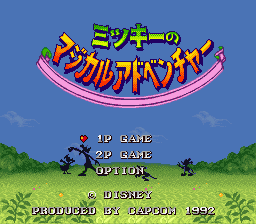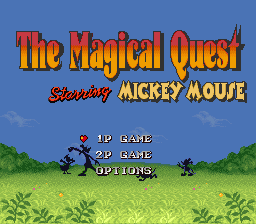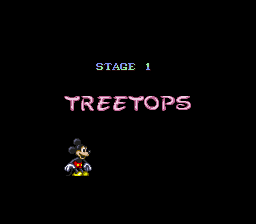If you appreciate the work done within the wiki, please consider supporting The Cutting Room Floor on Patreon. Thanks for all your support!
The Magical Quest starring Mickey Mouse
| The Magical Quest starring Mickey Mouse |
|---|
|
Also known as: Mickey's Magical Adventure (JP)
|
Mickey's back, and he's on a quest of the magical variety.
Contents
Sub-Pages
| Prototype Info |
| Notes |
Debug Functions

Hold Start + Select on both controllers before collecting a small heart. If done correctly, the Capcom Logo music will play, and the player will get the following items:
- Max Hearts.
- 990 coins.
- 9 Lives.
Additionally, the timer will be set to 990 seconds. Note that this only works for hearts that come from the small yellow boxes.
Controller Input Recorder
When memory address $7E028A is set to $01, a controller input log is created. This was likely used to record the demo gameplay sequences during development. However, no programming has been found that enables this feature in the retail version. In addition, the game is programmed to store the input log to SRAM, which is not present on the retail game PCB. To create a recording-enabled ROM (US version), patch the following 3 bytes in a hex editor:
Offset, Previous value -> New value, Description/Notes 007FD6 00 -> 02 Internal header - change from ROM only cartridge type to ROM + RAM + BATT cartridge type 007FD8 00 -> 01 Internal header - change from 0Kb SRAM to 16Kb SRAM (2048 bytes, range $0000-07FF, the SRAM is mapped to SNES address $700000-7007FF) 01BBDA 03 -> 00 Forces log mode ON
Once started, it begins to log what button(s) are pressed (if any) of Up, Down, Left, Right, Start, Select, Y, B, and how many frames they're pressed for. As there's no GUI for this recorder, you'll want to use a debugging emulator to monitor the SRAM. Once the 256 byte buffer is full, the game freezes in a loop until Down is pressed, at which point the memory is cleared and a new log started in its place. Set an execute breakpoint on address $01BCC9 and dump SRAM range $700000-7000FF to a file each time it triggers to keep successive logs. See Notes here.
Unused Text
Stage Select Menu
![]()
Text for a stage select menu that doesn't appear to be in the game anymore.
Use the Game Genie code DA60-64D9 to display this text when pausing the game.
Old Stage Bonus
| Early | Final |
|---|---|
 |
 |
An older version of the stage bonus text. Apparently, there used to be a time bonus, rather than the flat stage bonus used in the final version.
Use the Game Genie code 4460-64D9 to display this text when pausing the game.
Version Differences
Title Screen
| Japan | International |
|---|---|
 |
 |
The copyright information appears on the title screen in the Japanese version. "OPTION" was changed to OPTIONS in the international versions.
Options
| Japan | International |
|---|---|
 |
 |
Same change as above, pretty much.
Stage Intro
| Japan | International |
|---|---|
 |
 |
The odd grammar (XSTAGE) of the Japanese version was corrected (STAGE X) in the international versions.
- Pages missing developer references
- Games developed by Capcom
- Pages missing publisher references
- Games published by Capcom
- SNES games
- Pages missing date references
- Games released in 1992
- Games released in November
- Games released on November 20
- Games released in December
- Games with hidden development-related text
- Games with unused text
- Games with debugging functions
- Games with regional differences
- Mickey Mouse series
Cleanup > Pages missing date references
Cleanup > Pages missing developer references
Cleanup > Pages missing publisher references
Games > Games by content > Games with debugging functions
Games > Games by content > Games with hidden development-related text
Games > Games by content > Games with regional differences
Games > Games by content > Games with unused text
Games > Games by developer > Games developed by Capcom
Games > Games by platform > SNES games
Games > Games by publisher > Games published by Capcom
Games > Games by release date > Games released in 1992
Games > Games by release date > Games released in December
Games > Games by release date > Games released in November
Games > Games by release date > Games released in November > Games released on November 20
Games > Games by series > Mickey Mouse series
